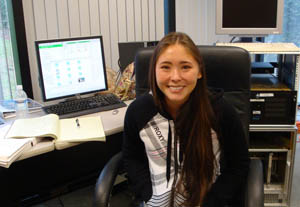Kimberly Oyama is currently a Computer Science major at the University of Hawaii, Hilo. She was raised on Lanai where she graduated from Lanai High School as the 2008 valedictorian.
Kimberly enjoys reading as well as sports and other outdoor activities such as hiking, hunting, diving, fishing, and horseback riding.
Institute when accepted: University of Hawaii at Hilo
Graphic User Interface for a Target Simulation Program Project Site: Textron Systems Mentor: Ross Matoi
Project Abstract:
Textron built a C program that simulates targets to test the tracking systems of their telescope mounts. This program (SIM) can simulate up to ten objects on four sensors using a target ephemeris, which describes each object and its characteristics. At the moment SIM is run using a command line interface, which makes it difficult to use. My goal for this project was to write a Graphic User Interface (GUI) for SIM to make it more user-friendly. The GUI, written in Tcl/Tk (a high level scripting language), is interfaced to SIM so the user can enter their data and press a button instead of entering multiple command lines. Boxes for data entry, labels for output display, and update buttons make it easy for the user to interact with SIM. I have also included other functions: sending SIM the name of the file to open, set a Missile launch time or launch immediately, and alerting the user of input errors. SIM stores data but it sends information to the GUI that does not need to be displayed immediately. The GUI can store such data in arrays of lists so the information is available if the user decides to display it. The widgets were tested by running the GUI through different situations, comparing the input to SIM and the output from SIM to those when SIM is run at the command line. In the future SIM and its GUI will expand to include databases for satellites and stars. This will provide a greater variety in testing and training scenarios for telescope operators using SIM.
